Betta fish - Raising the species in aquariums
Quick links - Answers
Brief Description
This article is a definite guide on raising Betta fish which also contains answers on FAQ that can be found under pictures. However you should visit these pages too: Siamese fighting fish - Betta splendens profile with huge forum, 10 tips for a successful Betta splendens reproduction, How to care for Betta Fish, Betta splendens diseases and proper treatment. Bear in mind we'd love to hear about your Bettas, therefore feel free to submit your story via the form that is at the bottom of this page!
Betta fish (known under scientific name Betta splendens) – also known as Siamese fighting fish – are one of the most beautiful tropical aquarium fish that can be kept in home aquariums, however their demands are often underrated which results in illnesses or compatibility issues. Let's describe all important aspects of raising these fish.
Tank setup for Betta fish
Ideal setup for Bettas is a heavily planted tank with slow water flow, subdued or medium lighting (0.2 – 0.3 Watt per litre which equals to 3.8 Watt per US gallon, or 4.54 Watt per Imperial gallon). A Betta tank should be shallow, not exceeding 30 cm (approximately 12 inches) in height which is extremely helpful in case of breeding as males look after eggs, and if they fall from nest, he collects them and puts them back (more information can be found below in the breeding paragraph). Secondly, Bettas have a labyrinth organ that allows them to breathe air from above the surface. Naturally they tend to breathe atmospheric air specifically if the level of oxygen in water gets too low, thus swimming from bottom parts of the tank to the surface might be exhausting in a case height of an aquarium is 50 cm (19.58 inch) or more. If you are using a lid on your tank then make sure that a 1 - 2 inch (2.54 - 5.08 cm) gap is present between the water surface and the lid of the tank, this still allows the fish to breathe and creates a humid atmosphere above the water column. As you can see, this is another reason why a planted tank is recommended for Siamese fighting fish – fish can spend countless hours laying on big leaves instead of laying on the substrate.
Maintaining water quality is crucial for breeding and having happy fish, thus:
- pH of 7 is just fine, they will tolerate pH of 6.2 – 7.9. However, pH must not vary on a random basis. Carbonate hardness must be 4 or ideally 5-6 in order for pH to be stable 24/7.
- Bettas aren't very demanding in regards of total water hardness (dGH), so it can be anywhere between 4 and 25 °N (71.43 - 446.43 ppm, 1.43 - 8.93 mEq).
- One of the most underrated variables is temperature – Bettas prefer warmer environments, so water of 27-28°C (80-82°F) is perfectly OK for this species and actually anything within the range of 23 - 30°C (73.4 - 86°F) is acceptable.
Optimal plants for a Betta tank are as follows:
- Vesicularia dubyana
- Vallisneria torta
- Vallisneria asiatica
- Synnema triflorum
- Hygrophila salicifolia
- Microsorium pteropus
- Rotala nanjenshan
- Hygrophila difformis
- Cryptocoryne affinis
- Ceratopteris thalictroides
- Crinum thaianum
- Cyperus helferi
- Blyxa aubertii
Ideal filtration for a Betta tank is an external canister filter which won't produce strong current in the tank as Siamese fighting fish dislike strong water movements, in addition they're prone to the White spot disease or internal infections if kept in inadequate conditions and in stressful conditions.
Bettas thrive in tanks with ordinary substrate – gravel, however sand can be used too. Avoid sharp rocks used as a substrate or decorations, because these fish spend a lot of time doing nothing but having a rest, thus they lay on various objects in a tank. If these fish get scared or chase other fish (eventually if other fish chases a Betta), they might collide with decorations or rocks; Fish may injure themselves, it isn't unusual when a fish loses its eye or if an open wound develops after running into cave or rock.
Caves and rockworks are a “must add” for every Betta tank since these fish love to hide in shady places. Also add several pieces of driftwood into the tank as these aid to lower pH and reduce flow of water.
Tank size and Temperament
Betta fish are often kept in vases, small bowls, cups or other insufficient/inappropriate containers. This is a thing to avoid at all costs as fish have no space to swim, but more importantly water chemistry in a 1 litre (0.26 US gallons, 0.22 Imperial gallons) container cannot be as stable as in a large tank that is say 15 or 20 times bigger. Adult Betta male will need at least 15 litres (3.96 US gallons, 3.3 Imperial gallons), same specification applies tothe adult Betta female.
Juvenile fish can be kept in tanks with their parents together until they are approximately 2 months old, this is the time when males must be separated, otherwise they're going to fight hard, actually to death. Tank size doesn't matter as long as you have two males in one aquarium! Males are known to fight to death, however females aren't that territorial and they tolerate males/females in same tank as long as it's big enough and offers places to hide.
Siamese fighting fish are classed as peaceful towards other species, this might be inaccurate if Bettas feel threatened, or if other larger fish feels threatened by Bettas. See the following paragraph for more information.
Tank mates
Ideal tank mates for Siamese fighting fish are peaceful bottom dwellers such as Corydoras, Loaches, Bristlenose catfish or other lazy fish that include Dwarf gourami for example. Actually more species can be added to a Betta tank, these include following:
- Indawgyi stream catfish
- Mottled loach
- Horseface Loach
- Badis
- Burmese badis
- Badis blosyrus
- Dwarf rasbora
- Zebra loach
- Burmese loach
- Banded gourami
- Yoma danio
- Giant moth catfish
- Kuhli loach
Many fish keepers have a bad experience with mixing Bettas with other species, however the issues are closely related to tank size and number of plants, hiding places, territories, driftwood or rocks. Additionally, fast swimming fish that occupy same levels of an aquarium aren't good tank mates for Bettas as they usually disturb Bettas. Even fish keepers who visited aqua-fish.net shared bad experiences such as “My Betta killed my other fish” or “My Betta was so stressed by Tetras that it got ill and died” with us.
The rule is not to mix fast swimming fish, and fish that originate from other geographical regions with Bettas. There's one exception – peaceful bottom dwellers such as Cory's or Pleco's.
Sexing and Breeding
Sexing Bettas is easy once they reach 3-4 months of age as this is the time when they become sexually mature. Males have nice and large fins while fins of females are much smaller, less coloured and their bellies are generally bigger than bellies of males.
Here below is an image of a male betta:
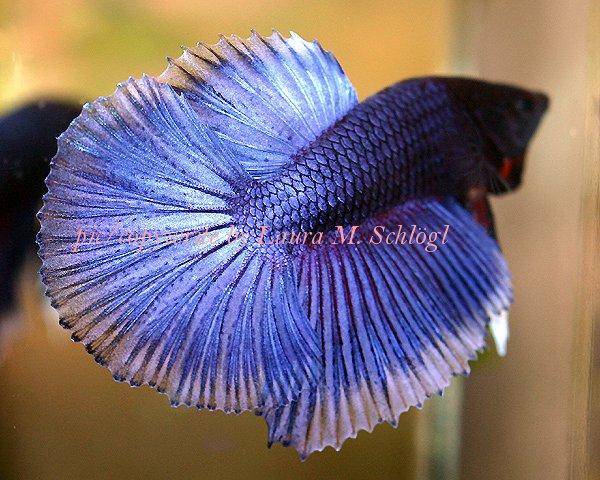
Here below is an image of a female betta:
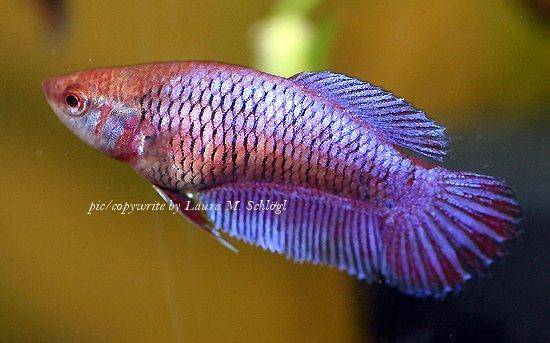
It's necessary to understand that young specimens do look very similar, so cases when aquarists bought “females” which turned to males as time went by aren't rare. Rather wait a couple of weeks before purchasing your new fish.
The breeding process is a pleasure to watch. All you need is a relatively large tank (50 litres, 13 US gallons, 11 Imperial gallons) which contains live plants, caves, rocks and driftwood. In this case floating plants are a “must add” as they keep the water surface still. Pistia stratiotes or Lemna minor should be present in a breeding tank.
The breeding process starts with mating, if a male is given a choice to choose from several females, he'll pick the most ready. He'll start building bubble nest on the surface (this is why still water is a must), this might take from 1 to 7 days. Once the female agrees on breeding, the male will take her into a U shape, this is when she releases eggs. Once the male guards the eggs, it's best to reduce flow of water to minimum, eventually use a sponge filter in the breeding tank. Eggs hatch in about 3 days and newborns won't need to be fed during the first few days as they're born with egg sac. Once this sac is consumed, they should be fed as stated below.
Bear in mind that if your breeding tank isn't big enough, it's right time to remove the female once the mating process ended as the male starts protecting eggs at this stage and any female (or other fish) near his nest is considered threat. Newborns should be fed newly hatched Artemia salina (Brine shrimp) or Microworms until they're big enough to accept commercial food or Daphnia.
Here's a list of factors that trigger willingness to breed:
- Increased temperature (28°C or 82°F)
- Often water changes
- Subdued lighting
- Spilling an extract of oak cortex into the tank
- Separating the pair from each other for a week or two
Bear in mind that every Betta female should release eggs at least once in every 3 months, otherwise she's at risk of becoming egg-bloated. This is the state when her eggs block internal organs, cause them to fail. Such a fish dies in pain.
Nutrition - Proper Diet
Ideal nutrition for Siamese fighting fish is live and frozen food – Worms and larvae (black and white mosquito larvae is liked by many Bettas). Brine shrimp or Daphnia are great addition to their diet too, however this species can be fed flakes on a daily basis in case there's no other choice. My Bettas didn't refuse granules that are actually made for Discus, Angelfish and mid-sized American cichlids. Bear in mind that mouth of Bettas is quite large, however their digestive system won't accept food that is bigger than what can be passed through the system. It's easy to spot whether given food is suitable or not by watching your fish during eating – if they spit out the food and eat it, then it's too big and should be crushed into smaller pieces.
Bettas should be given a “day off” once a week, they can be overfed too quickly, so let their digestive system relax on a regular basis. Never overfeed your Bettas.
pic/copywrite by Laura M. Schlögl

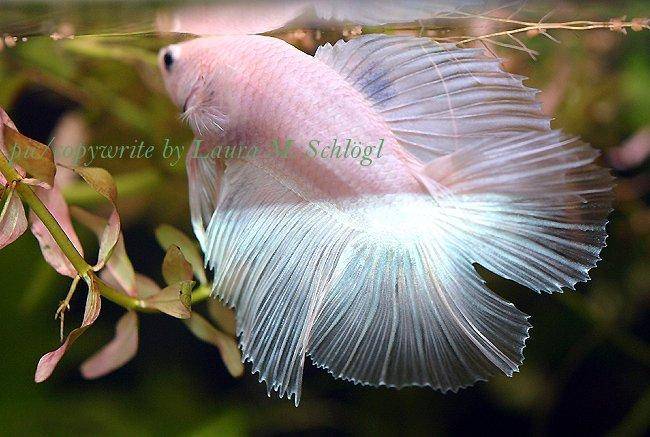
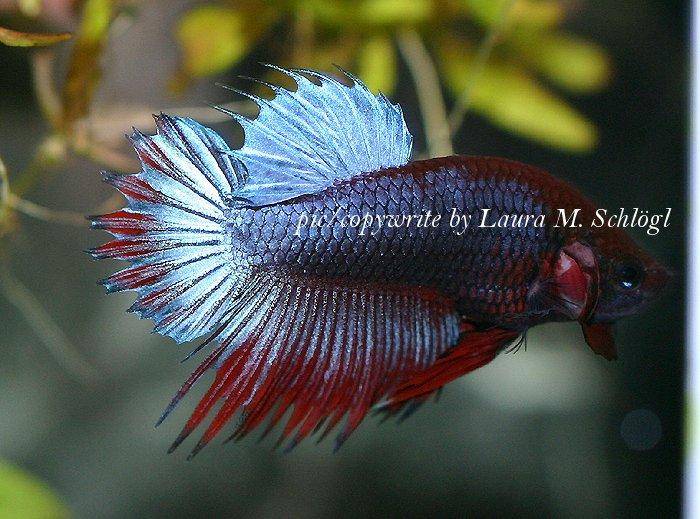
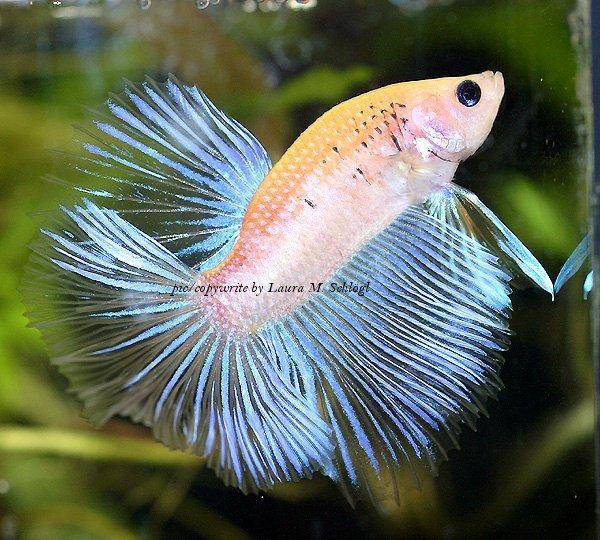
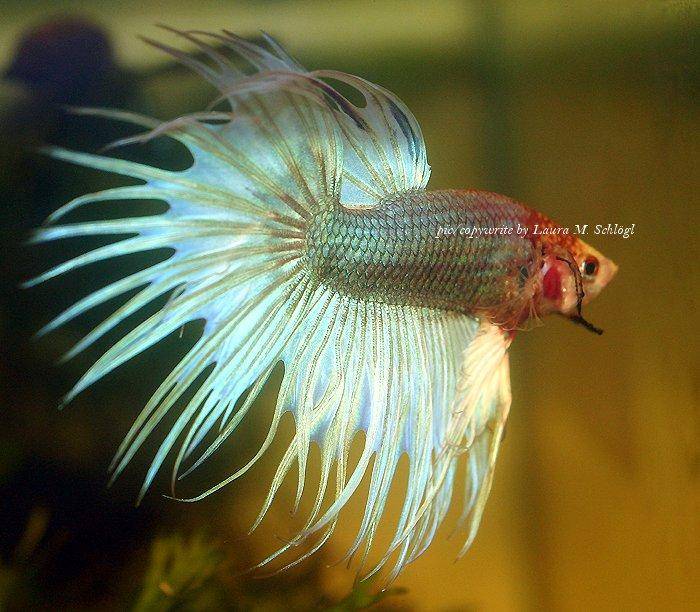
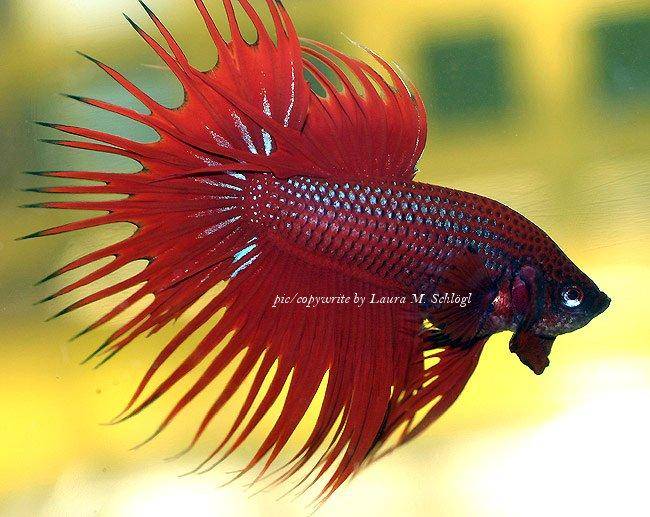
Questions and answers abuot Bettas
On March 16th 2011 we've updated this page with questions and answers that were previously published at aqua-fish.net/answers in order to put everything together. If you want to ask other question, feel free to do so and use the form at the bottom of this page, please! It's possible that some of the below-shown questions are answered above too, the intention was to give you as much information as possible and we're only humans. Bear in mind that all of these questions have been asked by our site's visitors; We wouldn't answer something that is not important to our visitors!
-
Why does my Siamese Fighting fish lay on the bottom of the tank?
Answer: This is normally a sign of less than perfect water conditions or the fish may have an illness. Checking the nitrate levels of your water will show if they are too high, if so do more regular water changes.
-
Why do male Siamese fighting fish blow bubbles when alone?
Answer: These fish create nests when they feel happy. They don't necessarily need a female to be present in the tank in order to start building a nest.
-
What happens when Bettas eat too much?
Answer: They become fat and this usually leads to health problems. Such Bettas' immune system is not strong. Especially when they become older, the probability of being sick will be much higher than in case of normally fed Bettas.
-
Which fish complement a Siamese fighting fish?
Answer: Siamese fighting fishes (males) are highly aggressive and will often be described as belligerent towards other males. It is not advised to let them live other males of the same species. The males will even exhibit aggression toward females of their own species.They are, however, peaceful toward species such as Tetras, Plecos, Loaches, Cory's and so on. Bettas may feel disturbed when there are too many fish in the tank and they will become shy in such a situation.
-
What happens when 2 male Betta Splendens are added to the same tank?
Answer: The first thing that will happen is that they will fight until one of the males has been killed. They will both try to claim the tank, so 2 males should never be placed together.
-
What fish will fight with bettas?
Answer: Other male bettas will attack and nip off fellow male bettas fins and females bettas may be harassed for breeding if housed with other male bettas. A good rule of thumb is to stay away from cichlids and fish with similar tail structures as the betta.
-
What happens if a male Betta takes a dislike to a female Betta?
Answer: The male Betta will terrorize the female and attack her. At the first sign of this the fish should be separated else the male will end up killing off the female.
-
Why is my Betta fish losing its colour?
Answer: This means that the Betta is getting stressed over something. This will lead to ill health in the fish. Betta fish do not like water flow, turning the filters down will help. Test the water to make sure that it is good quality water in the aquarium.
-
What is happening when a betta fish turns white?
Answer: Stress and disease or fungus can cause this to happen. It is recommended to test the water and eventually start a treatment.
-
What is the special water for the betta fish called?
Answer: Generally it is simply called betta water, but depending on what pet store you frequent it may have a brand name, one that I found is petco betta water found here: www.petco.com/product/12059/Betta-Water.aspx.
-
Which food will make my Betta strong?
Answer: Brine shrimp and bloodworms are ideal for Betta fish, Tetra Bettamin is also a specially designed flake food for Betta. Only feed sparingly as they have small stomachs.
-
What size of the tank should be used in breeding a Betta fish?
Answer: A 3 - 5 gallon (13.64 - 22.73 litres, 3.60 - 6.00 US gallons) tank is large enough for breeding Betta; remember, when the fry are hatched they will need to be moved to a larger growing on tank.
-
At what age will my Betta fish mate?
Answer: This can vary between individual fish but most Betta fish will become sexually responsive after the age of 3 months.
-
Is it safe to add a female fighting fish to the tank when the male is making a bubble nest?
Answer: This should be the prime time to add the female. Condition the female first with some live foods and when added to the tank, see if the male invites her to the bubble nest. If the first attempt does not succeed try adding a different female.
-
Why does my female Betta stay still when I add the male Betta?
Answer: The female may not wish to mate with the male or she may feel intimidated by his presence in the tank. Try separating them for longer or using a different male.
-
How can you tell when a female Betta has eggs?
Answer: Quite simply her belly will swell and a white spot will appear to grow in front of her anal fin.
-
When is mating season for Betta fish?
Answer: There is no specific mating season for these fish, getting the correct water conditions and feeding the right diet will often persuade the fish to mate.
-
What do you need to breed betta fish?
Answer: To start you need a male and a female. Then you need to ensure that they are getting a good quality diet, some live food will give them a boost. No circulation as this will disturb the bubble nest. The temperature must not go below 77 degrees Fahrenheit (25°C) and the pH should be near 6.5.
-
What do you do if your Betta has built a bubble nest in the tank?
Answer: Basically there is not a lot you can do. If the female is in the tank he will invite her over to the nest. The only way you can help them is to turn down the water flow on the filters so that the bubble nest will not get damaged.
-
How can I tell if my female Betta has laid her eggs?
Answer: Once the female has laid her eggs, her belly will have shrunken down in size and the male will be protecting the nest, this will include chasing the female away.
-
Why has my female Betta released her eggs before introducing the male?
Answer: This all depends on how long she has been holding the eggs. After a period of time her present eggs will be released ready for the next batch.
-
How do I feed my Betta fish fry?
Answer: Never feed the fry until they have absorbed the yolk sacs and are swimming horizontally. Their first meal should be micro worms, after the first day they should be fed twice a day.
-
What should the fry of Betta fish eat?
Answer: Artemia salina. They can also eat egg yolk.
-
When do Betta fry start to swim?
Answer: Betta fry become free swimmers once they have absorbed their yolk sacs. This normally takes 2-3 days. When free swimming, the male should be removed from the tank.
-
I have bought a Betta fish, how do I introduce him to the tank?
Answer: All fish need acclimatizing to your water conditions, float the bag for 20 minutes and then slowly add your tank water to the bag before releasing the fish.
-
Why are Betta fish kept in small bowls?
Answer: Betta fish do not like any water movement as they are not capable of swimming against it. They are also Labyrinth fish so do not need to obtain oxygen from the water. However, we do not recommend anyone to house Betta fish in small bowls!!!
-
How do you sex fighting fish fry?
Answer: There is no way of sexing any fish fry. As the young develop the male fighting fish will develop long flowing fins and bright colouration. The female will be much drabber with shorter finnage.
-
Why do my fighting fish just lie around?
Answer: Fighting fish prefer aquariums with no water flow and often this is not the case. If the tank is not set up to their liking they will show their disapproval and unhappiness by becoming inactive. Bad water quality can also lead to lethargy in the fish.







